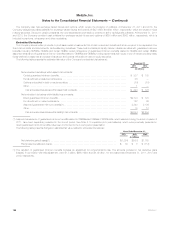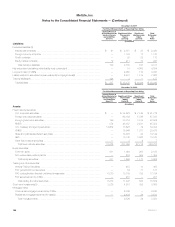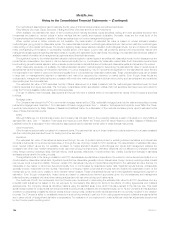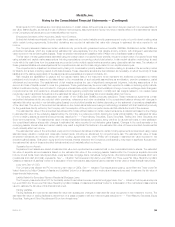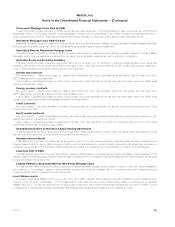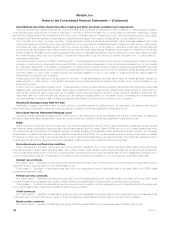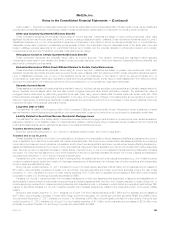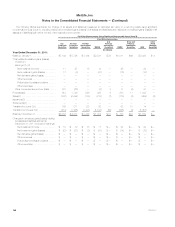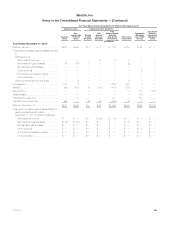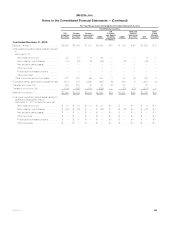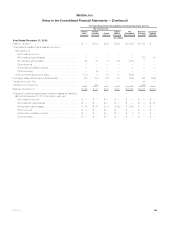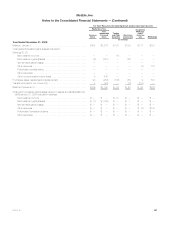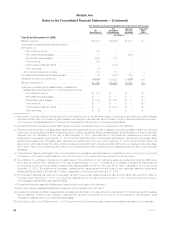MetLife 2011 Annual Report Download - page 162
Download and view the complete annual report
Please find page 162 of the 2011 MetLife annual report below. You can navigate through the pages in the report by either clicking on the pages listed below, or by using the keyword search tool below to find specific information within the annual report.MetLife, Inc.
Notes to the Consolidated Financial Statements — (Continued)
Fixed Maturity Securities, Equity Securities, Trading and Other Securities and Short-term Investments
This level includes fixed maturity securities and equity securities priced principally by independent broker quotations or market standard valuation
methodologies using inputs that are not market observable or cannot be derived principally from or corroborated by observable market data. Trading
and other securities and short-term investments within this level are of a similar nature and class to the Level 3 securities described below; accordingly,
the valuation techniques and significant market standard observable inputs used in their valuation are also similar to those described below.
U.S. corporate and foreign corporate securities. These securities, including financial services industry hybrid securities classified within fixed
maturity securities, are principally valued using the market and income approaches. Valuations are based primarily on matrix pricing or other similar
techniques that utilize unobservable inputs or cannot be derived principally from, or corroborated by, observable market data, including illiquidity
premiums and spread adjustments to reflect industry trends or specific credit-related issues. Valuations may be based on independent non-binding
broker quotations. Generally, below investment grade privately placed or distressed securities included in this level are valued using discounted cash
flow methodologies which rely upon significant, unobservable inputs and inputs that cannot be derived principally from, or corroborated by,
observable market data.
Structured securities comprised of RMBS, CMBS and ABS. These securities are principally valued using the market approach. Valuation is based
primarily on matrix pricing or other similar techniques that utilize inputs that are unobservable or cannot be derived principally from, or corroborated
by, observable market data, or are based on independent non-binding broker quotations. Below investment grade securities and RMBS supported
by sub-prime mortgage loans included in this level are valued based on inputs including quoted prices for identical or similar securities that are less
liquid and based on lower levels of trading activity than securities classified in Level 2, and certain of these securities are valued based on
independent non-binding broker quotations.
Foreign government and state and political subdivision securities. These securities are principally valued using the market approach. Valuation is
based primarily on matrix pricing or other similar techniques, however these securities are less liquid and certain of the inputs are based on very
limited trading activity.
Common and non-redeemable preferred stock. These securities, including privately held securities and financial services industry hybrid securities
classified within equity securities, are principally valued using the market and income approaches. Valuations are based primarily on matrix pricing or
other similar techniques using inputs such as comparable credit rating and issuance structure. Equity securities valuations determined with
discounted cash flow methodologies use inputs such as earnings multiples based on comparable public companies, and industry-specific
non-earnings based multiples. Certain of these securities are valued based on independent non-binding broker quotations.
Residential Mortgage Loans Held-For-Sale
Residential mortgage loans held-for-sale for which pricing for securities backed by similar loans is not observable, the estimated fair value is
determined using unobservable independent broker quotations or valuation models using significant unobservable inputs.
Securitized Reverse Residential Mortgage Loans
Securitized reverse residential mortgage loans for which pricing for securities backed by similar adjustable-rate loans is not observable, the estimated
fair value is determined using unobservable independent broker quotations or valuation models using significant unobservable inputs.
MSRs
MSRs, which are valued using an income approach, are carried at estimated fair value and have multiple significant unobservable inputs including
assumptions regarding estimates of discount rates, loan prepayments and servicing costs. Sales of MSRs tend to occur in private transactions where
the precise terms and conditions of the sales are typically not readily available and observable market valuations are limited. As such, the Company
relies primarily on a discounted cash flow model to estimate the fair value of the MSRs. The model requires inputs such as type of loan (fixed vs. variable
and agency vs. other), age of loan, loan interest rates and current market interest rates that are generally observable. The model also requires the useof
unobservable inputs including assumptions regarding estimates of discount rates, loan prepayments and servicing costs.
Derivative Assets and Derivative Liabilities
These derivatives are principally valued using an income approach. Valuations of non-option-based derivatives utilize present value techniques,
whereas valuations of option-based derivatives utilize option pricing models. These valuation methodologies generally use the same inputs as described
in the corresponding sections above for Level 2 measurements of derivatives. However, these derivatives result in Level 3 classification because oneor
more of the significant inputs are not observable in the market or cannot be derived principally from, or corroborated by, observable market data.
Interest rate contracts.
Non-option-based — Significant unobservable inputs may include pull through rates on interest rate lock commitments and the extrapolation beyond
observable limits of the swap yield curve and LIBOR basis curves.
Option-based — Significant unobservable inputs may include the extrapolation beyond observable limits of the swap yield curve, LIBOR basis
curves and interest rate volatility.
Foreign currency contracts.
Non-option-based — Significant unobservable inputs may include the extrapolation beyond observable limits of the swap yield curve, LIBOR basis
curves and cross currency basis curves. Certain of these derivatives are valued based on independent non-binding broker quotations.
Option-based — Significant unobservable inputs may include currency correlation and the extrapolation beyond observable limits of the swap yield
curve, LIBOR basis curves, cross currency basis curves and currency volatility.
Credit contracts.
Non-option-based — Significant unobservable inputs may include credit spreads, repurchase rates, and the extrapolation beyond observable limits
of the swap yield curve and credit curves. Certain of these derivatives are valued based on independent non-binding broker quotations.
Equity market contracts.
Non-option-based — Significant unobservable inputs may include the extrapolation beyond observable limits of dividend yield curves.
158 MetLife, Inc.




